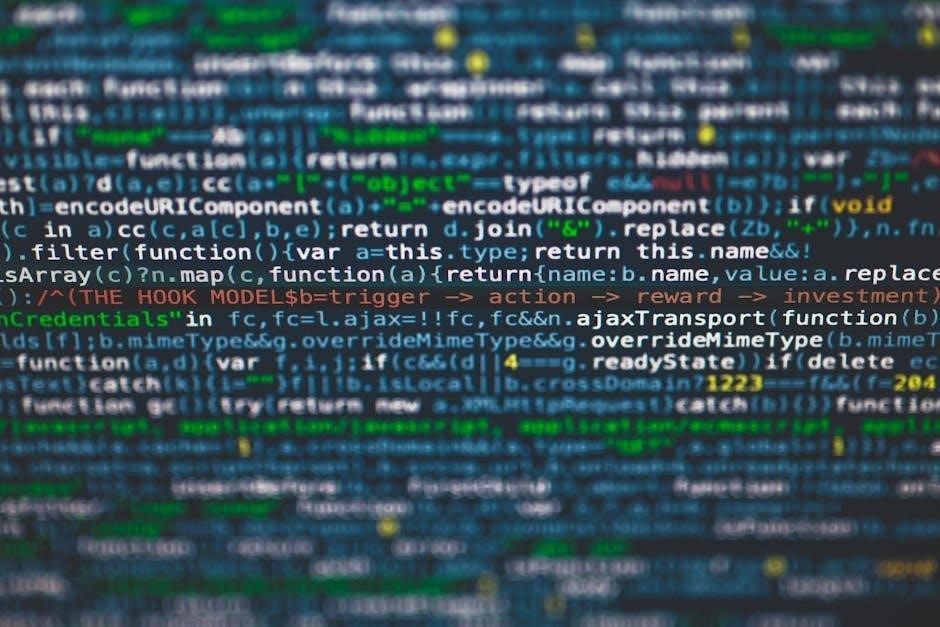NMFC codes are a standardized system for classifying freight, ensuring efficient and cost-effective shipping. The 2023 updates provide detailed guides in PDF format, aiding accurate classification and compliance.
What Are NMFC Codes?
NMFC codes, or National Motor Freight Classification codes, are a standardized system used to classify freight for shipping purposes. They help determine handling, packaging, and shipping costs. The codes categorize items based on factors like density, weight, and handling requirements. In 2023, updated NMFC codes and guides were released in PDF formats, ensuring compliance and accurate classification. These codes are essential for efficient LTL (less-than-truckload) shipping operations.
2023 updates include detailed guidelines to enhance clarity and precision in freight classification.
Importance of NMFC Codes in Freight Shipping
NMFC codes are crucial for efficient freight shipping as they standardize classification, ensuring accurate cost calculations and handling procedures. They help carriers determine shipping costs, handling requirements, and safety measures. Proper classification prevents billing disputes, reclassifications, and delays. The 2023 updates in PDF formats enhance compliance and precision, making shipping operations smoother. By using NMFC codes, businesses ensure cost accuracy, safety, and efficiency in logistics, avoiding potential penalties and operational inefficiencies.
Accurate NMFC classification is essential for seamless and cost-effective freight management.
Overview of the NMFC Code System
The NMFC code system is a standardized method for classifying commodities in freight shipping. It categorizes items based on density, handling characteristics, and other factors to determine shipping costs and procedures. The system includes classes ranging from 50 to 500, with lower classes for dense, easy-to-handle items and higher classes for lightweight, bulky, or fragile goods. The 2023 updates, available in PDF format, provide detailed guidelines to ensure accurate classification and compliance. This system is essential for efficient, safe, and cost-effective LTL shipping operations.
Understanding the NMFC code system is key to proper freight classification and logistics management.

How NMFC Codes Work
NMFC codes classify commodities based on density, handling, and other factors. The 2023 PDF guidelines ensure accurate classification, reflecting shipping costs and handling requirements efficiently.
The Classification Process
The classification process involves evaluating a shipment’s density, weight, and handling characteristics. The 2023 NMFC PDF guidelines outline detailed steps, ensuring accurate freight categorization. Shippers measure cargo dimensions, calculate density, and reference the NMFC code lookup tools to assign the correct class. Proper classification prevents reclassifications and ensures smooth shipping operations.
Key Factors in Determining NMFC Codes
Density, weight, and handling characteristics are critical in determining NMFC codes. The 2023 NMFC PDF guidelines emphasize calculating density by dividing weight by cubic feet. Freight is also classified based on its susceptibility to damage, ease of handling, and special requirements like refrigeration or hazardous materials. Accurate classification ensures proper handling, safety, and cost efficiency, preventing reclassifications and additional fees during shipping. Understanding these factors is essential for compliance with the latest NMFC standards and seamless logistics operations.
How Freight Class is Calculated
Freight class is calculated using a combination of weight, density, and handling characteristics. The 2023 NMFC PDF guidelines outline a density scale to determine class ratings. Density is calculated by dividing the item’s weight by its cubic footage. Higher density items typically receive lower class ratings, while lighter, bulkier, or fragile items are assigned higher classes. This system ensures consistent pricing and handling standards, helping shippers avoid costly reclassifications and delays. Accurate calculations are essential for compliance and efficient logistics operations under the updated NMFC standards.

Obtaining NMFC Codes
The 2023 NMFC codes are available in PDF format, offering detailed classification guides. Use lookup tools or consult logistics experts to ensure accurate freight classification and compliance.
Where to Find NMFC Codes
NMFC codes can be found in the official National Motor Freight Classification directory or through logistics providers. The 2023 updated codes are available in PDF format, ensuring easy access and accurate classification. Online databases and specialized lookup tools also provide comprehensive lists of NMFC codes, catering to specific commodities. Freight classification guides and industry resources further simplify the process, offering detailed instructions for determining the correct codes. These sources are essential for shippers to ensure compliance and efficient freight operations.
Using NMFC Code Lookup Tools
NMFC code lookup tools simplify the classification process by providing quick access to updated codes. These tools, often available online, allow users to input commodity details and receive the correct NMFC code instantly. The 2023 PDF guides and databases integrate with these tools, ensuring accurate and efficient classification. By leveraging advanced search features, shippers can streamline their operations and avoid errors. These tools are particularly useful for determining the correct codes for complex or specialized items, reducing the risk of misclassification and associated costs.
Role of Logistics Providers in NMFC Classification
Logistics providers play a vital role in NMFC classification by offering expertise and resources to ensure accurate freight coding. They utilize updated 2023 NMFC codes and guides to classify commodities correctly, minimizing errors and ensuring compliance. Their knowledge of NMFC standards helps shippers avoid costly reclassifications and delays, ensuring smooth operations and cost-effective shipping solutions.
Many logistics providers offer tools and databases that simplify the classification process, making it easier for businesses to navigate the complex NMFC system. Their support is invaluable for maintaining efficiency and adherence to industry standards.

Understanding Freight Classes
Freight classes range from 50 to 500, determined by density, handling, and commodity type, ensuring efficient and cost-effective shipping as per 2023 NMFC guidelines.
Low-Class Freight (50-85)
Low-class freight, categorized as NMFC codes 50-85, includes dense, heavy, and durable items like bricks, machinery, and hardwood flooring. These items are easy to handle and transport, minimizing shipping costs and risks. Proper classification ensures accurate pricing and efficient logistics. Using the 2023 NMFC guidelines, shippers can easily identify and classify these commodities, avoiding potential disputes or additional fees. This classification is essential for cost-effective and hassle-free LTL shipping operations.
Medium-Class Freight (125-250)
Medium-class freight, categorized under NMFC codes 125-250, includes items like household appliances, electronics, and furniture. These commodities are less dense than low-class freight but still relatively easy to handle. Proper classification is crucial to avoid reclassification fees or shipping disputes. The 2023 NMFC guidelines provide detailed instructions for accurately determining the class of medium-class freight, ensuring efficient and cost-effective shipping. This range strikes a balance between weight, density, and handling requirements, making it a common classification for a wide variety of goods.
High-Class Freight (300-500)
High-class freight, classified under NMFC codes 300-500, includes lightweight, bulky, or delicate items like fragile electronics, assembled furniture, and high-value goods. These commodities require special handling due to their susceptibility to damage or theft. The 2023 NMFC guidelines emphasize accurate classification for such items to prevent reclassification fees and ensure proper handling. High-class freight often involves additional shipping costs due to increased liability and handling complexity. Proper classification is essential to maintain efficiency and safety in logistics operations.

Special Considerations
Special considerations in NMFC classification include hazardous materials, high-value items, and refrigerated goods, each requiring unique handling and documentation to ensure safety and compliance with 2023 guidelines.
Hazardous Materials Classification
Hazardous materials require special classification under NMFC codes to ensure safe handling and transport. The 2023 NMFC guidelines provide detailed instructions for categorizing hazardous goods, emphasizing proper packaging, labeling, and documentation. These codes account for factors like flammability, toxicity, and reactivity to determine appropriate handling procedures. Accurate classification is critical to avoid delays, penalties, or safety risks. Shippers must adhere to strict regulations, including those from the Department of Transportation (DOT), ensuring compliance with both NMFC standards and federal safety protocols.
High-Value or Delicate Items
High-value or delicate items require special classification under NMFC codes to ensure proper handling and minimize risk. The 2023 NMFC guidelines emphasize precise categorization for items like fragile electronics, fine art, or luxury goods. These codes account for factors such as item fragility, monetary value, and required security measures. Accurate classification ensures appropriate packaging, insurance, and care during transit, preventing damage and costly claims. Proper NMFC coding for high-value or delicate items is essential for maintaining customer trust and avoiding financial losses due to mishandling or misclassification.
Refrigerated Goods Classification
Refrigerated goods require specialized classification under NMFC codes to ensure proper handling and temperature control. The 2023 NMFC guidelines provide detailed classifications for perishable items, such as food, pharmaceuticals, and biological materials. These codes account for factors like temperature requirements, packaging, and handling procedures to maintain product integrity. Accurate classification is crucial to prevent spoilage, comply with regulations, and avoid costly reclassifications. Proper NMFC coding ensures refrigerated goods are stored and transported safely, meeting both carrier and regulatory standards for perishable shipments.

2023 Updates to NMFC Codes
The 2023 NMFC updates introduced new codes, revised classifications, and compliance requirements to enhance accuracy and efficiency in freight shipping operations.
Changes in Freight Classification
The 2023 NMFC updates introduced significant changes in freight classification, including new codes for emerging commodities and revised guidelines for handling hazardous and high-value items. These adjustments aim to improve accuracy and reflect industry trends, ensuring safer and more efficient shipping practices. The updated system also streamlined classification processes, reducing errors and enhancing compliance. Carriers and shippers must adhere to these changes to avoid reclassifications and additional fees, ensuring smooth operations in the LTL shipping sector.
New NMFC Codes Introduced
In 2023, new NMFC codes were introduced to accommodate evolving shipping needs, particularly for emerging commodities. These codes provide clearer guidelines for classifying items like fragile electronics and high-value goods. For instance, Class 85 now covers automotive parts, while Class 125 applies to household appliances. Classes 250-400 are reserved for electronics and clothing, with 400-500 designated for bulky or delicate items. These updates ensure accurate classification, reducing errors and ensuring cost-effective, safe shipping practices. The 2023 NMFC codes are available in detailed PDF formats for easy reference.
Compliance Requirements for 2023
In 2023, compliance with NMFC codes requires shippers to adhere to updated classification guidelines. Accurate freight classification is essential to avoid penalties and ensure smooth shipping operations. Shippers must use the latest NMFC code lookup tools and consult the 2023 NMFC code PDF guides for proper commodity classification. Misclassification can lead to reclassifications, fines, and delays. Staying informed about updates and using trusted resources helps maintain compliance, ensuring cost accuracy and operational efficiency in LTL shipping.

Benefits of Accurate NMFC Classification
Accurate NMFC classification ensures cost savings, reduces shipping disputes, and enhances operational efficiency. It streamlines logistics, avoids penalties, and ensures compliance with 2023 NMFC guidelines.
Cost Savings
Accurate NMFC classification directly reduces shipping expenses by eliminating incorrect charges and minimizing the risk of costly reclassifications. Proper use of 2023 NMFC codes ensures carriers bill correctly, avoiding additional fees. This precision also optimizes freight density calculations, leading to more efficient load planning and lower overall transportation costs. By adhering to updated guidelines, businesses can allocate resources more effectively, enhancing profitability and maintaining competitive pricing in the market.
Reduced Shipping Disputes
Accurate NMFC classification minimizes shipping disputes by ensuring clear communication between shippers and carriers. Proper use of 2023 NMFC codes eliminates misunderstandings about freight handling and charges, reducing billing conflicts. With precise classifications, both parties can agree on shipping terms upfront, leading to fewer arguments and a smoother process. This clarity fosters trust and strengthens business relationships, making shipping operations more efficient and reliable while ensuring compliance with updated guidelines.
Improved Efficiency in Logistics
Accurate NMFC classification enhances logistics efficiency by streamlining shipping processes. With the 2023 NMFC codes in PDF format, businesses can quickly access updated guidelines, ensuring proper freight handling and reducing delays. This leads to faster turnaround times, better resource allocation, and improved delivery schedules. By minimizing errors and ensuring compliance, accurate NMFC codes help logistics teams operate more effectively, optimizing overall supply chain performance and maintaining smooth operations across the entire shipping network.

Challenges in NMFC Classification
The complexity of the NMFC system, risk of reclassification, and frequent updates pose challenges. Staying informed about 2023 changes and using accurate codes is essential for compliance.
Complexity of the System
The NMFC system’s complexity arises from its detailed classification process, involving density, handling, and liability. With thousands of codes, updates like those in 2023 add layers of intricacy, requiring precise understanding. Misclassification risks increase due to nuanced criteria, making it challenging for shippers to navigate without specialized tools or expertise. The constant evolution of commodities and shipping requirements further complicates the system, emphasizing the need for up-to-date resources and training to ensure accuracy and compliance.
Risk of Reclassification
Reclassification poses significant risks, including unexpected fees, delays, and shipment rejections. Misclassifying freight based on NMFC codes can lead to carrier audits and costly adjustments. Inaccurate density calculations or overlooked handling requirements often trigger reclassifications. Staying updated with 2023 NMFC guidelines and using reliable lookup tools are crucial to minimize such risks. Proper documentation and understanding of commodity characteristics help ensure accurate classifications, avoiding financial penalties and operational disruptions. Regular training and adherence to NMFC standards are essential to mitigate reclassification risks effectively.
Need for Regular Updates
Regular updates to NMFC codes are essential to reflect industry changes, new commodities, and evolving shipping requirements. The 2023 NMFC guide provides the latest classifications, ensuring compliance and accurate shipping processes. Failure to update can lead to misclassification, financial penalties, and operational inefficiencies. Staying informed about NMFC changes helps shippers adapt to new rules and maintain cost efficiency. The 2023 updates emphasize critical revisions, making it imperative to reference the latest NMFC codes for seamless and compliant freight operations.

Tools and Resources
Utilize NMFC code lookup tools, freight classification guides, and online databases for accurate 2023 NMFC codes. These resources ensure compliance and efficient freight operations.
NMFC Code Lookup Tools
NMFC code lookup tools simplify freight classification by providing quick access to updated 2023 codes. Online databases, mobile apps, and logistics platforms offer searchable directories to ensure accurate classifications. These tools reduce errors by matching commodities with correct NMFC codes, considering factors like density and handling requirements. Regularly updated to reflect 2023 changes, they help avoid reclassifications and ensure compliance. By streamlining the process, NMFC lookup tools enhance efficiency and cost accuracy for shippers and logistics professionals, making them indispensable for modern freight operations.
Freight Classification Guides
Freight classification guides are essential resources for accurately assigning NMFC codes. They provide detailed instructions for categorizing commodities based on factors like density, handling, and value. Available in PDF formats, these guides are regularly updated, such as in 2023, to reflect industry changes. By following these guides, shippers can ensure compliance, avoid reclassifications, and optimize shipping costs. They also include examples and tiered classification systems, making it easier to understand and apply NMFC codes correctly for various types of freight, from high-value items to hazardous materials.
Online Databases for NMFC Codes
Online databases provide quick access to NMFC codes, offering comprehensive search tools for accurate freight classification. These databases are regularly updated, including the 2023 changes, and feature detailed guides and examples. They allow users to search by commodity or code, ensuring efficient lookup. Many databases also include cross-referencing features and historical data, aiding compliance and reducing errors. With user-friendly interfaces, these platforms simplify the classification process, making it easier to navigate the complex NMFC system and ensure correct code assignment for various shipments.
Accurate NMFC classification ensures cost savings, reduces disputes, and streamlines logistics. Staying informed about updates like the 2023 changes is crucial for efficient and compliant freight operations.

Importance of Staying Informed
Staying informed about NMFC code updates, such as the 2023 changes, is vital for shippers, carriers, and logistics professionals. Accurate classification ensures compliance, avoids costly reclassifications, and streamlines operations. Regular updates reflect industry changes, ensuring safety and efficiency. Accessing the latest NMFC guides in PDF format or using lookup tools helps maintain compliance; Proactive knowledge of NMFC updates prevents disputes, optimizes shipping costs, and enhances overall logistics performance. By staying informed, businesses can adapt to evolving freight classification standards and ensure smooth, efficient operations.
Best Practices for NMFC Code Usage
Adhering to best practices for NMFC code usage ensures accurate classification and efficient shipping. Start by consulting the latest 2023 NMFC guides in PDF format for updated codes. Use reliable lookup tools or work with logistics experts to avoid errors. Provide detailed commodity descriptions on bills of lading to prevent disputes. Regularly review and update classifications to comply with industry changes. Training staff on NMFC code usage and leveraging technology for real-time updates can further enhance accuracy. By following these practices, businesses can optimize shipping processes and minimize costly reclassifications.
